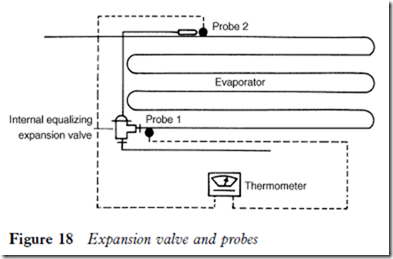Thermal bulb
Generally the performance of the thermostatic expansion valve depends upon the correct location of the thermal bulb. This should be clamped firmly to a horizontal section of the suction line near to the evaporator outlet if possible, and preferably within the refrigerated space. The entire length of the bulb should make good thermal contact with the pipework, as illustrated in Figure 18.
The location of the bulb relative to the diameter of the tubing is also important. It must never be located on the underside of the pipework, where it will register false temperatures because of the presence of oil in the pipework.
Valve settings
Manufacturers will stipulate the setting of new expansion valves. They are generally set to maintain a superheat of 3.5 to 5 °C or 7 to 9 °F.
Different evaporators require different settings of the valve to keep the coils correctly flooded. It is accepted that optimum operating conditions are achieved when thermostatic expansion valves are set to within the following: Dry expansion, gravity coil: 5 to 7 °C or 9 to 12 °F.
Forced air evaporator coil: 1.5 to 3 °C or 3 to 5 °F.
It is evident that if a factory set valve with a 7 °C setting is fitted to a forced air evaporator, too much superheating will take place. By adjusting the valve to within the accepted range, say 4 °C, less superheating will occur and the evaporator will be more efficient.
Figure 19 shows two conditions of the refrigerant in a gravity coil at different settings of the expansion valve.
